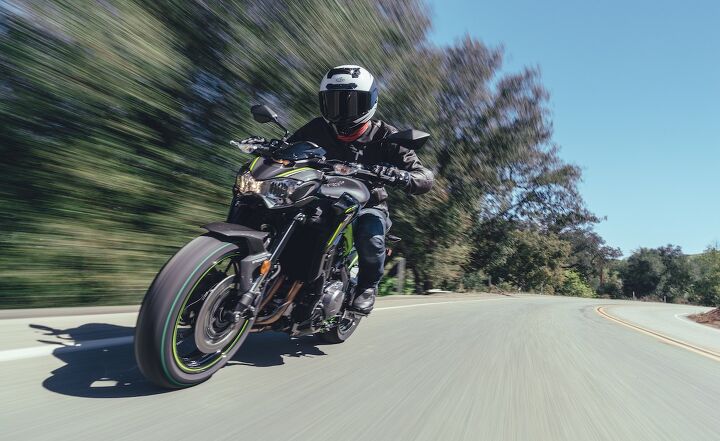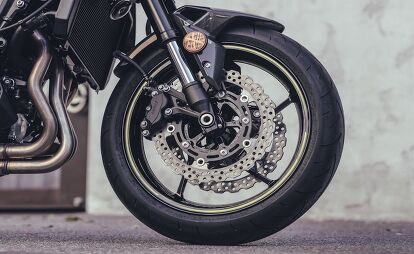2017 Kawasaki Z900 Review: First Ride
For all those traditionalists/purists who bemoan modern motorcycle electronics (TC, ride modes, electronic suspension, etc.), Kawasaki has a bike for you. The 2017 Kawasaki Z900 in this review is lighter and more agile than either the Z800 or Z1000, is more powerful than the Z800, costs way less than the Z1000, and is devoid of electronics save its gear-position indicator.
2017 Kawasaki Z900
| Engine | 19.0/20 |
| Suspension/Handling | 11.5/15 |
| Transmission/Clutch | 9.5/10 |
| Brakes | 8.25/10 |
| Instruments/Controls | 3.75/5 |
| Ergonomics/Comfort | 8.75/10 |
| Appearance/Quality | 8.75/10 |
| Desirability | 8.5/10 |
| Value | 9.25/10 |
| Overall Score | 87.25/100 |
2017 Kawasaki Z650 First Ride Review
Kawasaki did outfit the Z900 with mechanical technology in the form of an assist and slipper clutch – which makes for an incredibly light pull at the clutch lever, and the ability to bang a series of downshifts without fear of hopping the rear wheel uncontrollably – but otherwise the bike is elemental: engine, frame, suspension, brakes. Correctly combining those four ingredients remains a delicate balance, but with the Z900, Kawasaki appears to have a winning package.
Beginning with claimed curb weights, we see the Z900 at 463.1 pounds (ABS model, 458.6 pounds for non-ABS) is 24.2 pounds lighter than Z1000 (487.3 pounds), and a whopping 46.3 pounds lighter than Z800 (509.4 pounds). Like the Ninja 650 and Z650 we recently tested, Kawasaki’s weight-loss program can be seen across the new-for-2017 spectrum, as those motorcycles also enjoy considerably lighter curb weights.
Kawasaki Z900 | Yamaha FZ-09 | MV Agusta Brutale 800 | Triumph Street Triple 765 |
|---|---|---|---|
463 lbs. | 425 lbs. | 413 lbs.* | 395 lbs.* |
Even with its hefty wet weight, the Z800 managed to best the Suzuki GSX-S750 in our 2016 Gentleman’s Hooligan Comparo. So, weight isn’t the be all end all when it comes to motorcycle performance, and it shows with the Z900. Weighing significantly less than the 800, the Z900 was almost guaranteed to be a better performer, and our day aboard the new Z in the mountains and canyons of San Diego county proved the new 900 to be an agile and capable naked.
The Z900 welcomes quick transitions and confidently holds its line through long sweepers. The 41mm inverted fork, adjustable for rebound damping and spring preload, does a commendable job handling surface irregularities but is a little vague at communicating precisely what’s happening at the front wheel. The same can be said of the rear monoshock (also adjustable for preload and rebound), but considering the bike’s price point, both suspension units are a reasonable compromise.
Power production from the 948cc inline four-cylinder is linear across the tach with a noticeable uptick in rev speed around 6,000 rpm. I noticed the tach naturally sitting around 5,500 rpm during spirited riding, ready to smooth into the meat of the Z900’s power curve. Sans traction control, the easy-to-use power delivery is certainly welcome, but those who like to feel acceleration will appreciate the 6k-rpm bump.
Z800 | Z900 | Z1000 | |
|---|---|---|---|
Claimed Horsepower | 111 | 126 | 140 |
Claimed Torque | 70 | 73 | 82 |
Z900 riders will also appreciate all the effort Kawasaki put into developing the bike’s intake snarl. Inhalation noise grows evermore pleasant as revs swing past the 6,000 mark toward the bike’s 11,000 rpm redline. It’s a cacophony only the rider hears, and so serves a secondary purpose of leaving those around the Kawi unoffended by what appears to be a quiet motorcycle.
On the freeway at 75 mph, the inline-Four is spinning just below its power threshold, making passing an easy chore. And at nearly every speed regardless of gear, the Z900’s engine remained remarkably smooth, with no excessive secondary vibrations emanating through the seat, footpegs or handlebars – not something we often say about four-cylinder engines. The Z is easy to maneuver around town and at parking-lot speeds thanks to a wide steering angle.
2017 Kawasaki Z900
+ Highs
- Weighs less than both Z800 and Z1000
- Linear power delivery with a bump around 6,000 rpm
- Affordably priced
– Sighs
- Still heavy compared to competitors
- Should have traction control
- Instrument cluster is just OK
The Z900 has its rider in a comfortably aggressive seating position with enough forward lean to help with wind blast, and a relatively short reach to not-too-wide but not-too-narrow handlebars. When testing the Ninja 650 a while back, we complained about the shortage of legroom for taller riders, but even though the Z900 enjoys a lower ride height of 31.3 in., compared to 32.8 in. and 32.1 in. for the Z800 and Z1000, respectively, I didn’t notice any knee cramps by the end of the day. Speaking of inches, it was interesting to note that the Z900 has a slightly longer wheelbase (57.1 in.) compared to the 800 (56.9 in.) and 1000 (56.5 in.), but it still felt more nimble than either of those bikes.
At $8,399, the standard Z900 costs the same as the outgoing 2016 Z800ABS. Add ABS to the 900 and the price goes up $400 to $8,799, but even at that price, it’s still $3,200 less than the Z1000ABS. Having ridden all three Zs, we’re willing to say that the Z900 is better than both of its siblings with room to spare. How it stacks up against its current competitors (FZ-09, Street Triple 765, Brutale 800) will be fun to investigate.
2017 Kawasaki Z900 Specifications | |
|---|---|
| MSRP | $8,399 / $8,799 with ABS |
| Engine | 4-stroke, liquid-cooled, DOHC, four valves per cylinder, inline-four |
| Displacement | 948cc |
| Bore x Stroke | 73.4 x 56.0mm |
| Compression ratio | 11.8:1 |
| Fuel System | DFI with 36mm Keihin throttle bodies |
| Ignition | TCBI with electronic advance |
| Transmission | 6-speed |
| Final Drive | Sealed chain |
| Front Suspension | 41mm inverted fork with rebound damping and spring preload adjustability/4.7 in |
| Rear Suspension | Horizontal back-link, stepless rebound damping, adjustable spring preload/5.5 in |
| Front Tire | 120/70 ZR17 Dunlop Sportmax D214 |
| Rear Tire | 180/55 ZR17 Dunlop Sportmax D214 |
| Front Brakes | Dual 300mm petal-type rotors with four-piston calipers, ABS |
| Rear Brakes | Single 250mm petal-type rotor with single-piston caliper, ABS |
| Frame Type | Trellis, high tensile steel |
| Rake/Trail | 24.5°/4.1 in |
| Overall Length | 81.5 in |
| Overall Width | 32.3 in |
| Overall Height | 41.9 in |
| Ground Clearance | 5.1 in |
| Seat Height | 31.3 in |
| Curb Weight | 463.1 lb (claimed) |
| Fuel Capacity | 4.5 gal |
| Wheelbase | 57.1 in |
| Color Choices | Pearl Mystic Gray/Metallic Flat Spark Black, Metallic Flat Spark Black/Metallic Spark Black |
| Warranty | 12 Month Limited Warranty 12, 24, 36 or 48 months Kawasaki Protection Plus (optional) |
Gallery
A former Motorcycle.com staffer who has gone on to greener pastures, Tom Roderick still can't get the motorcycle bug out of his system. And honestly, we still miss having him around. Tom is now a regular freelance writer and tester for Motorcycle.com when his schedule allows, and his experience, riding ability, writing talent, and quick wit are still a joy to have – even if we don't get to experience it as much as we used to.
More by Tom Roderick



























































Comments
Join the conversation
They can give you upside-down fork but they cant give you radial caliper to go with it. come on! now if only we can mod one in.
The frame looks weak about the convergence point of the vertical engine structure.
That being said, I'd prefer gusseting in that area.